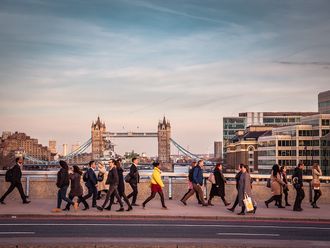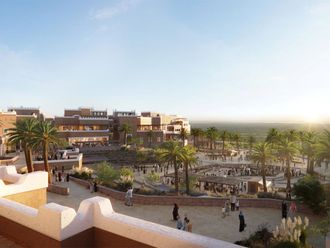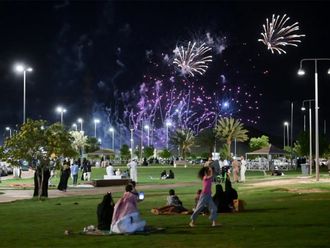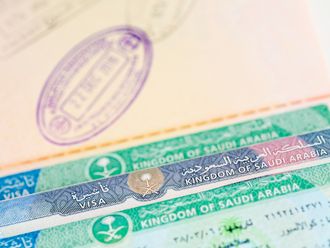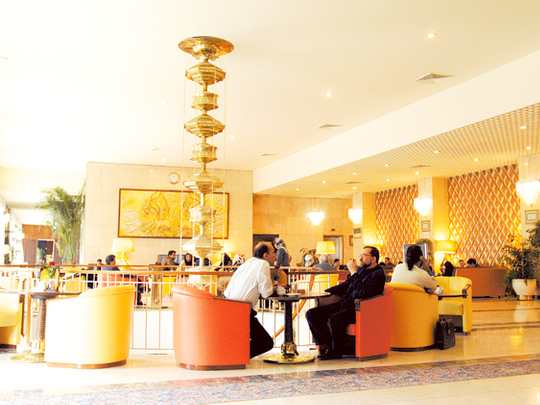
Tehran: Beyond the vast sun-drenched courtyard of Esfahan’s Imam Mosque and its intricate 17th- century tiled stalactites, an audience of four Belgians and a Polish woman listens patiently to a young Iranian cleric.
Dressed in robes and turban, he explains in flawless English the differences between Islam’s two dominant sects and why the religion tells women to cover their hair. Smiling, the Belgians have photographs taken with the theologian.
“We want to try and establish relationships so more people visit,” Mostafa Rastegar, who was visiting from his seminary in the holy city of Qom, said after his talk.
Foreign visitors to Iran are the most visible effect of President Hassan Rouhani’s drive to mend ties with the U.S. and Europe, an influx that one his deputies said generated as much as $5 billion for the sanctions-hit economy over the past year. For the first time since the 1979 Islamic Revolution, international hotel chains are now plotting a return, while European airlines are adding or restoring links with Tehran.
Between March 21 and April 20, the first month of the Iranian year, 4,594 foreign tour groups visited Iran, more than double the number that arrived in same period last year, said Morteza Rahmani-Movahed, deputy of the government’s Tourism and Heritage Organization. Iran wants to remove or ease visa requirements for 12 countries to draw more visitors, Intelligence Minister Mahmoud Alavi has said.
Saudi Arabia’s Rotana Group plans to open five-star hotels in Tehran and the Shiite pilgrimage city of Mashhad.
Austrian Airlines AG resumed direct flights to Tehran from Vienna in March. Iranian officials have been in talks with the Italian government and Alitalia SpA to increase the frequency on routes, the official Fars News Agency reported on April 30, citing the deputy head of Iran’s Civil Aviation Organization.
“The stability of the political situation will have an important impact on the economy,” Rahmani-Movahed said. “There has to be a relationship with the rest of the world.”
Representatives from Italy, Germany, the Netherlands and several Arab countries, including Oman and Kuwait, have also visited Iran on “fact-finding” trips aimed at seeking future opportunities to invest in Iranian tourism, he said.
A moderate cleric, Rouhani, 65, promised a rapprochement with the world powers that tightened economic sanctions on Iran under predecessor Mahmoud Ahmadinejad over the country’s nuclear program. Among his first pledges after taking office in August last year, Rouhani said he planned to improve the quality of the tourism industry and draw more foreign travellers.
Tourism is a major part of Iran’s “economy of resistance,” Intelligence Minister Alavi has said, referring to Supreme Leader Ayatollah Khamenei’s program to make the national less vulnerable to international sanctions over its nuclear work.
Travel and tourism accounted for 6.3 per cent of Iran’s $482 billion economy in 2012, according to an estimate by the World Economic Forum in a report last year.
Vice President Masoud Soltanifar, who also heads the heritage organisation, referred to a “tsunami of foreign tourists” currently hitting Iran.
Taking into account Shiite pilgrims and visitors from neighbouring countries such as Azerbaijan, he said more than 4 million overseas visitors toured Iran from March 2013 to March 2014, each accounting for an estimated $1,200 of revenue, according to a report by the official Islamic Republic News Agency. In 2012, there were 3.8 million international tourist arrivals, according to the World Bank.
Lonely Planet said appetite for information about Iran has prompted the publisher to dedicate a chapter on the country in the update to its Middle East travel guide due next year.
In the courtyard of the Abbasi Hotel in Esfahan, a central city directly south of Tehran, packs of retirement-age Europeans sit among quince trees and date palms. Well-heeled Iranian teenagers take selfies against the stunning backdrop of a restored 350-year-old caravanserai, once an inn for merchants passing along the Silk Road.
“This time last year, about 40 per cent of our guests were foreigners,” said Bakhtiar Haddadi, general manager of the Abbasi said from his office overlooking the courtyard. This year, “80 per cent of them are from overseas,” he said.
Haddadi, who has managed the hotel for 14 years, wouldn’t disclose earnings, though said all 225 rooms were fully booked until June, with the exception of a few large suites kept empty for high-ranking guests. The hotel’s most expensive room, which features bulletproof windows and reproductions of Safavid-era Persian floral motifs and was once for the exclusive use of the deposed Shah of Iran, costs about $266 a night.
To accommodate the growing demand from overseas guests, the Abbasi, which is owned by Iran’s largest state insurer, Bimeh Iran, plans to build a new wing on a nearby parking lot, providing an additional 150 rooms, according to Haddadi.
“Thankfully with the election and the changes that have taken place, we’ve seen a thawing of the ice,” he said. “Negative perceptions of Iran are changing.”
While diplomats negotiating over Iran’s atomic program ended the latest talks in Vienna this month without advancing their bid to reach a deal by July, more meetings are planned for June and Iranian officials say they are confident of success.
Most tourists arrive as part of package tours, according to officials. They visit during two peak seasons: April to early June, and September to October.
Many follow a route that takes them from Esfahan to the ancient Zoroastrian centre of Yazd and then on to the southern city of Shiraz, close to the 2,500-year-old ruins of the Achaemenid Empire. Here, the entrance to the city is flanked by two imposing craggy cliffs, and the granite-clad facade of a five-star hotel looms out from one of these vast rocks.
The Shiraz Grand Hotel took almost 17 years to build, according to its owners, and opened six months ago to reap the rewards of what they say is a surge of foreigners into the city.
In the hotel’s lobby, Austrian tourist Edith Howorka, 61, who has just returned from a tour of the 520BC relics of the palace of Darius the Great, said her experience of Iran had so far been “absolutely positive.”
“I like to visit countries with a very interesting culture and history,” said Howorka. “But during Ahmadinejad’s time it would never have struck me to come here. I would have felt like an enemy of the country.”
Shiraz’s tourism and heritage organisation said that between March and April it sold 6,193 tickets to foreign visitors to the ruins of Persepolis, compared with 1,651 tickets sold in the same period last year.
With foreigners paying a premium of 150,000 rials, about $5, per ticket, the influx represents a 275 per cent increase in the city’s revenue from the relics of Iran’s ancient past.
The problem for the tourism industry is that some hotels and attractions can’t cope with the jump in visitors. Basic facilities can be a challenge to find and westerners may balk at the traditional squat toilets.
Younes Yahya, general manager of Esfahan’s five-star Kowsar Hotel, the main rival of the Abbasi, said more needs to be done so different parts of the economy can cater to visitors.
“We were unprepared for the number of guests we’ve had this year so far,” said Yahya, who has seen 100 per cent growth in foreign guests on last year. “Right now, different sectors are acting independently of each other and not coordinating at all. We need a consortium for businesses and services related to the tourism industry.”
London teacher Ruth Standing, 33, who was travelling independently, said at a teahouse filled with trinkets in Esfahan that more could also be done to make it easier for tourists to prepare for a visit to Iran, such as information on visas.
“It was so difficult for me to get a visa,” said Standing. “I was surprised to see so many tourists when I finally arrived here.”
— Washington Post


